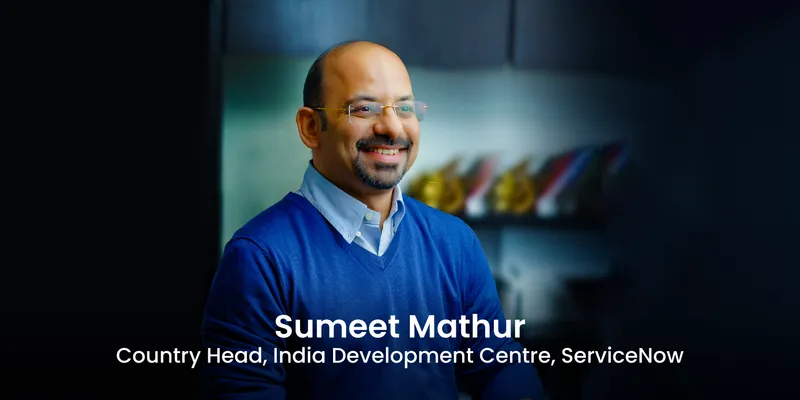'Real-time response to risks is relevant for any business'
Sumeet Mathur, Country Head of ServiceNow's India Development Centre, on the changing face of enterprise workflow since the onset of the pandemic.
Digital workflows platform ServiceNow has tripled its headcount in India over the past two years. It has R&D centres in Bengaluru and Hyderabad making India the largest facility for ServiceNow after its headquarters in Santa Clara, California.
Globally, ServiceNow clocked $4.5 billion in 2020 revenue, 95 percent of which is from its subscription services. The remainder is from professional services. Its Now platform delivers workflow automation for enterprises to optimise business processes. ServiceNow grew 31 percent over the previous year.
In this interview with EnterpriseStory, Sumeet Mathur, Vice President, Engineering and Head of ServiceNow India Development Centre (IDC), explains how digital workflow management has evolved, particularly in the context of the COVID-19 pandemic.

EnterpriseStory: What is ServiceNow's proposition in enabling digital workflows?
Sumeet Mathur: A lot of us take actions throughout a day that move the organisation forward, but sometimes this hinders us from doing high-value work.
What enterprises seek to do more than before is to transform old manual ways of working into modern digital workflows, so employees and customers get what they need, when they need it, and from where they need it in a fast, simple and easy manner. When people do better, business works better.
The truth is too many solutions have failed to solve the problem of supporting modern business. An IDC study found that organisations have invested $3 trillion on digital transformation globally in the past three years. Yet, only 26 percent of them reported a return on investment. That's an incredibly low success rate.
The pandemic has also brought about this unimaginable change to the world in response to companies needing digitisation—to operate in new and faster ways, pivoting their processes and business models in order to compete, or even to survive nowadays.
The challenge for many enterprises is that with a fragmented approach, the work is unstructured and happens in disparate systems of record. It happens in silos that lowers productivity and user experience, because individuals in an enterprise do not have the support on how workflows across the enterprises are connected, which creates a a bottleneck for them.
We transform their old manual ways of working into modern digital workflows on the Now platform, which flows through a company or across several functions for a unified experience.
Our differentiation is providing the enterprise with a single platform, with in-built capabilities and tools for anyone to build their apps.
There are four direct lines of business, which we call 'workflows'. We have the IT workflows, which unite IT and risk management, and security operations on a single platform that helps CIOs to deliver more resilient services, aligned with customer-centric varieties.
Second, our employee workflows boost employee engagement and productivity, providing a unified experience across departments in an enterprise. Third, customer workflows that drive customer loyalty with connected digital workflows.
We also have creative workflows that help customers build connected digital workflow apps by themselves on a low code platform.
Enterprise Story: What has driven investments in the India Development Centre? Does ServiceNow operate in the Indian market?
Sumeet Mathur: The India Development Center is an ongoing investment in India. We are the largest R&D centre in Asia, and second-largest globally, because we have the world's best engineering talent.
ServiceNow has tripled its employee base in India in the past two years. Some of the industries we focus on in India are telecommunications, manufacturing, financial services, along with some of the large conglomerates.
We have been delivering digital workflows to Indian organisations since 2004 because we have seen a particularly strong appetite for digital transformation. Our customer base here includes Tech Mahindra, Tata Communications, and Bharti Airtel.
EnterpriseStory: What are the applications of the platform?
Sumeet Mathur: The intent is to help unite everything a CIO (Chief Information Officer) needs to deliver modern resilient services. That means delivering high-performance business services with full visibility at any given time.
The platform has to help enterprises know what its assets are, how to optimise costs and improve efficiency, and the full asset lifecycle. It helps organisations identify, prioritise, and respond to security incidents and vulnerabilities faster based on the risks and insights that a CIO has right now.
Similarly, responding to business risks in real time with continuous monitoring, prioritisation, and automation is relevant for any enterprise in any industry.
EnterpriseStory: What makes operations technology (OT) management vital?
Sumeet Mathur: That's part of our IT workflow that safeguards OT systems. It gives a context-rich view and digital workflows that one can use to respond quickly to threats.
It enables enterprises to have data, so that the management can prioritise incidents and changes, and address them before they start impacting operations. It also helps reduce risk and streamline compliance efforts for vulnerability detection, and so that you can respond quickly.
EnterpriseStory: How have employee workflows evolved during the pandemic?
Sumeet Mathur: A great example of ServiceNow’s employee workflow is the Safe Workplace App suite, which is being used by organisations around the world to safely bring their people back to offices.
The Safe Workplace App suite comprises a range of tools, such as employee health declarations, desk bookings, personal protective inventory management, and more. The data from various apps of the suite are brought together on a dashboard that provides management with a clear overview of employees returning to office, and allow for quick decision-making.
The Safe Workplace App suite is powered by the Now platform’s ability to break down department silos to create unified employee experience across IT, HR, facilities, legal, and more, making it easy for employees to navigate complex processes, and get the information they need in their preferred channels.
Edited by Kunal Talgeri






